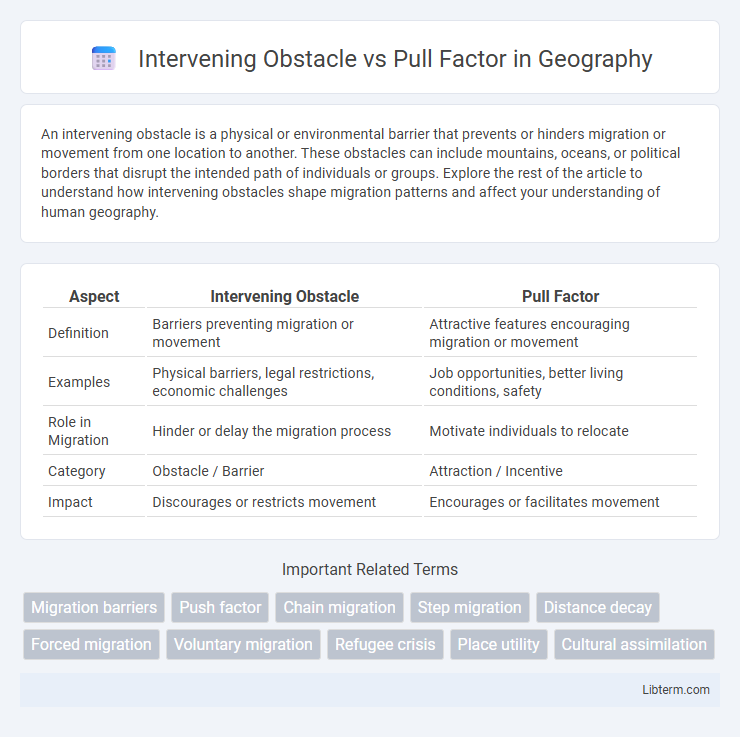An intervening obstacle is a physical or environmental barrier that prevents or hinders migration or movement from one location to another. These obstacles can include mountains, oceans, or political borders that disrupt the intended path of individuals or groups. Explore the rest of the article to understand how intervening obstacles shape migration patterns and affect your understanding of human geography.
Table of Comparison
| Aspect | Intervening Obstacle | Pull Factor |
|---|---|---|
| Definition | Barriers preventing migration or movement | Attractive features encouraging migration or movement |
| Examples | Physical barriers, legal restrictions, economic challenges | Job opportunities, better living conditions, safety |
| Role in Migration | Hinder or delay the migration process | Motivate individuals to relocate |
| Category | Obstacle / Barrier | Attraction / Incentive |
| Impact | Discourages or restricts movement | Encourages or facilitates movement |
Defining Intervening Obstacles
Intervening obstacles are barriers that hinder or delay migration between an origin and a destination, such as geographical challenges, legal restrictions, or financial limitations. These obstacles contrast with pull factors, which are positive attributes attracting migrants, like job opportunities, political stability, or better living conditions. Understanding intervening obstacles is crucial for analyzing migration patterns and the complexities migrants face during their journey.
Understanding Pull Factors
Pull factors are positive attributes or opportunities that attract individuals to a new location, such as job availability, better living conditions, and educational prospects. Understanding pull factors is critical in migration studies as they directly influence decision-making by offering tangible benefits that outweigh the challenges posed by intervening obstacles. These factors help explain migration patterns and regional population growth by highlighting why certain destinations are more desirable.
Key Differences Between Obstacles and Pull Factors
Intervening obstacles refer to barriers such as physical, economic, or political challenges that impede migration or movement, while pull factors are positive attributes like employment opportunities, better living conditions, or political stability that attract individuals to a new location. Key differences include that obstacles restrict or delay movement by creating difficulties, whereas pull factors actively encourage relocation by offering benefits and incentives. Understanding these distinctions is essential in migration studies, as obstacles highlight deterrents and pull factors emphasize motivators influencing population flows.
Common Examples of Intervening Obstacles
Common examples of intervening obstacles include physical barriers like mountains and oceans, political restrictions such as visa requirements and border controls, and economic challenges including lack of funds for travel and difficulty securing employment. These obstacles often delay or prevent migration despite strong pull factors like better job opportunities or improved living conditions. Understanding these barriers helps explain why migrants sometimes settle en route or choose alternative destinations.
Major Pull Factors in Migration
Major pull factors in migration include economic opportunities, better living conditions, and political stability, which attract migrants to specific destinations. These pull factors often outweigh intervening obstacles such as geographic barriers, legal restrictions, or financial costs that migrants face during relocation. Understanding how strong pull factors influence migration decisions helps explain population shifts despite the presence of significant intervening challenges.
The Role of Distance and Geography
Intervening obstacles such as physical barriers, harsh climates, and vast distances significantly impact migration by increasing travel costs and risks, often deterring movement despite attractive pull factors like better job opportunities or living conditions. Geography shapes these obstacles through mountain ranges, deserts, or oceans that migrants must navigate, influencing their routes and decisions. In contrast, pull factors rely on proximity and accessibility; shorter distances and favorable geography amplify their effectiveness in attracting migrants.
Economic Motivations vs Barriers
Intervening obstacles such as visa restrictions, high transportation costs, and limited job opportunities often hinder migrants' ability to reach economically thriving destinations despite strong pull factors like higher wages and better employment prospects. Economic motivations drive individuals towards regions with robust labor markets and improved living standards, yet barriers like language differences and lack of social networks can significantly restrict mobility. Understanding the balance between economic incentives and structural obstacles is crucial for analyzing migration patterns and policy impacts.
Political and Social Influences
Intervening obstacles in migration often include political barriers such as restrictive immigration laws, visa denials, and political instability in transit countries that hinder movement. Pull factors driven by social influences encompass established diaspora communities, social networks, and perceived social freedoms that attract migrants to specific destinations. The interplay between political obstacles and social pull factors shapes migration patterns by either impeding migrant flow or enhancing destination appeal.
Case Studies: Real-World Applications
Intervening obstacles, such as visa restrictions and economic barriers, significantly impact migrant decisions in case studies like Syrian refugees navigating European borders, while pull factors, including job opportunities and political stability, attract migrants to destinations like Canada and Germany. Research on Central American migrants reveals how intervening obstacles like border enforcement contrast with pull factors such as family reunification programs in the United States. Analysis of South Asian migration to the UK highlights the interplay between intervening obstacles like language barriers and pull factors including educational prospects, illustrating real-world applications in migration policy.
Intervening Obstacles and Pull Factors in Modern Migration Trends
Intervening obstacles such as immigration policies, visa restrictions, and economic barriers significantly influence modern migration by limiting migrants' ability to reach preferred destinations. Pull factors, including job opportunities, political stability, and better living standards, attract migrants to countries like the United States, Canada, and Germany. The dynamic interplay between these challenges and attractions shapes global migration patterns and responses to labor market demands.
Intervening Obstacle Infographic

 libterm.com
libterm.com